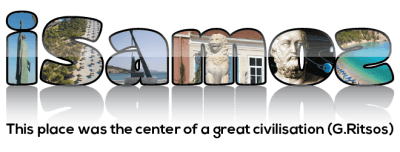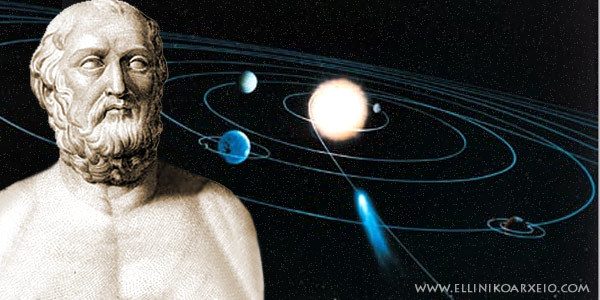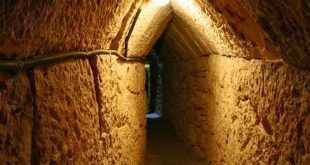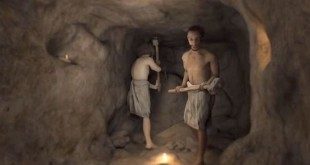From Aristarchus to Copernicus: New horizons in human though
Since the very early stages of human history, mankind tried to understand and explain its own existence, based on his knowledge and observations. Focusing attention on the numerous and impressive celestial phenomena, primitive man made his first evolutionary steps towards scientific approach by observing two fundamental phenomena: The daily axial rotation of the celestial sphere and the annual transitional movement of the sun. For many centuries mankind struggled to cope with, understand and demonstrate how these two movements are created. In other words, mankind tried to understand if this is happening due to the behavior of the stars, in relation to the steel Earth or is happening due to Earth’s rotation in relation to its axis, as Earth rotates around the sun (i.e. the steel center of the world). Naturally, there was a division between the sages of antiquity into two opposing factions: The advocates of the geocentric theory of the world and the advocates of the heliocentric theory of the world. The first were the vast majority, while the second were the minority.
The belief in the correctness of the geocentric theory was great, it had a purely religious origin and it was based on the firm belief that Earth, as the residence of the gods, the tranquility of which should not be disturbed, is the steel center of the universe and all celestial bodies move around it in perfectly circular orbits. Therefore, within the framework of the geocentric theory, we, as observers, possess a privileged position within the universe. This, unacceptable in nowadays, conclusion was quite important because it was a very simple one, in aesthetic terms (i.e. simple circular orbits around us) and, for this reason, it was easily acceptable, in scientific terms (i.e. simple natural laws).
The appearance of the Greek philosophers, some 2.500 years ago, in ancient Ionia (Asia Minor, nowadays Turkey), lead to a scientific revolution. But what exactly was this revolution? The answer is simple and short: Chaos created the world. A universe, which derived from Chaos, was in complete accordance with the beliefs of the ancient Greeks, within an unpredictable nature, ruled by capricious gods. But during the 6th century BC, in Ionia, a new concept was developed, according to which the universe is understandable, because it has an internal order and because nature consists of regularities, which allow for the disclosure of its secrets and functions. Nature is not completely unpredictable, because there are rules, which nature itself has to obey. This order and admirable character of the universe, the ancient Greeks named “Cosmos” (“World”), which means “beauty” or “ornament”.
This revolution took place in Ionia and not in any of the major cities of India, Egypt, Babylonia, China or Central America. In comparison with these places Ionia had many advantages. Firstly, it was an island kingdom (isolation, even though imperfect generates variety). Due to its many islands it was characterized by a variety of political systems, while no force existed, powerful enough to impose social and intellectual uniformity. Consequently, free search and research was possible, while, at the same time, superstition could not be considered as a political correct necessity. Unlike other nations, Ionians were at the crossroad of different cultures and not at the center of a single civilization. Phoenician alphabet was firstly adopted and used by the Ionian Greeks, thus allowing the spread of writing and education. Therefore, the thoughts and ideas of many people were available for discussion, debates or controversy. Besides, political power was in the hands of merchants, who actively promoted technological progress, in order to achieve their own economic aims.
In general it can be argued that the key for the revolution was manual labor, along with experimentation and observation. In fact, some the most brilliant Ionian thinkers were the offspring of sailors, farmers, and weavers, all of them quite accustomed with manual labor. There, in Eastern Mediterranean, the great civilizations of Egypt and Mesopotamia met and interacted within a framework of intense arguments regarding prejudices, languages, institutions, ideas, and gods. So, the “big idea” was conceived, i.e. the realization of the fact that there are principles, forces, and natural laws that can be understood without the need to interpret a specific phenomenon, for example, the fall of a bird through direct action by Zeus himself.
Aristarchus of Samos: The Greek pioneer of the heliocentric system
From Thales to Hypatia (lived between 650 BC and 450 AD), the contribution of the Ionian philosophers to the formation of modern astronomical and cosmological science is decisive. Especially Aristarchus, an astronomer, mathematician and geometer of the Alexandrian School, who was born in Samos and lived in the 3rd century BC (310-230 BC), was the rapporteur, the preacher, and the supporter of the radical, for its time, heliocentric theory. According to this theory the apparent movement of a planet is, as observed from Earth, periodically correct (i.e. the planet appears to move in the same direction, like Earth does), and then counterclockwise (backwards).
In order to explain this kind of movement of the planets, including that of the Sun and the Moon, ancient Greeks invented the geocentric system of the world (or else Ptolemaic, named after Claudius Ptolemy). According to the geocentric system, the planets move around Earth in epicycles (Epicycle System). In other words, a planet is moving smoothly in a circular orbit around the center of the epicycle, which in turn is moving smoothly in a circular orbit, the center of which is almost identical to Earth. In this way the ancient Greeks managed to represent the apparent movements of the planets (clockwise and counterclockwise). This complex but wonderful system was completely and absolutely accepted as the predominant system of the world. In reality, however, planets perform elliptical orbits, around the Sun, so the hypothesis of the uniform circular orbits simply didn’t match reality. The observed differences, known to the ancient Greeks, remained unexplained. Such phenomena, can be easily solved and proved if, in accordance with the heliocentric system of Aristarchus, the Sun is positioned where the ancient Greeks believed that Earth was positioned.
Aristarchus wrote many works and papers, most of which have not survived through time. But his theory, regarding the Sun as being at the center of the Solar System, is indisputably recorded by several ancient Greek philosophers like Archimedes, Stobaeus and Plutarch. So there is no doubt about the paternity of this theory.
Besides, Aristarchus is the inventor of “Skafion” (i.e. a type of sundial), with which he was able to determine the exact time of the correct midday in a certain place (and to define time, in general, within the daylight span). He was also able to determine the latitude of this place, the value of obliquity of the ecliptic orbit, the Sun’s daily deviation, and the days of equinoxes and solstices of the year 281 BC. Along with Heraclides Pontius (the so-called Ponticus), Aristarchus is considered among the first who explained the daily rotation of the celestial sphere as a direct result of Earth’s axial rotation. He also explained the sequence of seasons as a result of the inclination of Earth’s axis of rotation in relation to the ecliptic level. He is the first Greek astronomer who gave the most accurate value of the apparent diameter of both the Sun and Moon. It seems that he had some idea of the truly huge distances between the stars, Sun included. In 288 or 287 BC, Aristarchus succeeded Theophrastus as the head of the Peripatetic School, a position he held for eight years. Moreover Aristarchus invented a quite valuable method of determination of the relative distances between the Earth and the Sun and between the Earth and the Moon (he used the diameter of the lunar orbit as a measurement unit). The result, however, was 20 times less that the exact distance, but it was used for several centuries ahead, while this specific method of calculation proves that Aristarchus had the ability to understand the geometric theory of celestial phenomena. Moreover, he invented an equally important method of determination of the relative dimensions of three stars (Earth, Sun, and Moon). Out of the known (and more or less equal) apparent diameters of the Sun and the Moon, he managed to calculate the diameters of both stars (using Earth’s diameter as a measurement unit). Perhaps the discovery that the actual diameter of the Sun is twenty times bigger than the actual diameter of the Moon, combined with the understanding that the distance between the Sun and the Earth is twenty times the distance between the Moon and the Earth led Aristarchus to conclude that the Sun, not the Earth, is the center of the world.
The introduction of the heliocentric theory proves that Aristarchus was able to understand and explain, in a clear and correct manner, the observed celestial phenomena, without being influenced by the centuries-long accepted but mistaken beliefs of his contemporaries. Besides, the invention and use of “Skafion” (sundial) proved that he could solve practically, not just theoretically, certain astronomical problems, while was able to invent and use the appropriate instruments. In other words, Aristarchus was a skillful observer of celestial phenomena. Essentially, Aristarchus is the father and the founder of Astronomy, on the basis of logical thinking and not on the basis of religious beliefs.
The moment of Renaissance
It is obvious that Aristarchus was the first astronomer who proposed the acceptable, in nowadays, heliocentric theory and founded astronomy on the basis of logical thinking, a reality which, unfortunately, part of the international astronomical community, either justified, or by ignorance, or even unjustified, does not seem to fully share. Unfortunately for the heliocentric theory, the strongest supporters of the geocentric theory were great scientists and philosophers such as Pythagoras, Aristotle, Hipparchus and Ptolemy… Consequently, the revolutionary idea put forth by Aristarchus could not be fully and universally accepted. It fell into oblivion, but was not forgotten, until the era of Renaissance, when in 1543, some 2.000 years after Aristarchus, his theory was vindicated by the famous Polish astronomer Nicolaus Copernicus. Even though Copernicus simply brought back into surface the heliocentric theory, thus repeating the ideas of Aristarchus, he is considered today, as the one who actually introduced the heliocentric theory. Indeed, today the universally accepted heliocentric system is still called “Copernican” (i.e. “of Copernicus”) and not “Aristarcheion” (i.e. “of Aristarchus”) as it should be called.
The survival of the heliocentric theory, despite the polemic mood of its rivals, was less due to Copernicus and more due to the overwhelming evidence presented in its favor by many great minds of the past, among them Galileo, Kepler, Newton, and others. It is, therefore, valid to wonder whether or not Copernicus’s work is genuine and ask what its actual value is. To answer this question must first take into account the difficulties of the era, in which Copernicus lived, during which the doctrines of Aristotle prevailed in an absolute manner and now one was actually allowed to disagree. Furthermore, criticism towards Copernicus’s theories began almost immediately and was particularly intense.
Although Copernicus’s contribution to the revival of the heliocentric theory is important, this is not sufficient enough in order to attribute the paternity of the theory to him. It is quite clear that Copernicus was familiar and knew the views of Aristarchus. This is clearly evident by a preserved excerpt of his original treatise manuscript entitled “De Revolutionibus Orbium Coelestium”. In this excerpt the paragraph, which refers to the treatise of Aristarchus, is deleted. Strangely, however, this deleted paragraph is not included in the printed edition of Copernicus’s treatise, published in 1543. This is characterized, by some people, as plagiarism, while others consider it either as lack of courage or cowardice on Copernicus behalf. It should be noted however that it is not clear whether this deletion can or should be attributed to Copernicus himself or to his typographer instead, since the printed edition of his treatise was published posthumously. It is also noteworthy that Copernicus did not authorize, for an entire decade, the printing and publishing of his treatise, out of fear of condemnation by the Roman Catholic Church. Finally, in 1543, it was published, in Nuremberg (Germany) a copy of his manuscript which was condemned by the Vatican in 1616.
Therefore, Copernicus is not the rapporteur of the heliocentric theory. He is rather the one who pulled out from oblivion and popularized the heliocentric theory, the paternity of which belongs exclusively to Aristarchus. Copernicus’s contribution mainly lies in the fact that he introduced the geometric mechanism of Ptolemy’s geocentric system in Aristarchus’s heliocentric system. But it is clear that, since the real difficulty (i.e. the belief that the planets move smoothly in circular orbits) could not be overcome, his whole effort was moving on a wrong path. To restore truth and for reasons related to historical self-knowledge, the greater possible information, regarding the work of the great Greek astronomer Aristarchus, is needed, because Aristarchus was one of the leading figures amongst the ancient Greek astronomers, mathematicians, and philosophers.
(This article is courtesy of Mr. Nicholas K. Spiros, professor of Physics in the Aristotelian University of Thessaloniki).
 iSamos.gr Η ενημερωτική σελίδα της Σάμου! Εξερευνήστε τη Σάμο, τις παραλίες της, τη φύση της, τις ομορφιές της. Διαβάστε την ιστορία της Σάμου
iSamos.gr Η ενημερωτική σελίδα της Σάμου! Εξερευνήστε τη Σάμο, τις παραλίες της, τη φύση της, τις ομορφιές της. Διαβάστε την ιστορία της Σάμου






